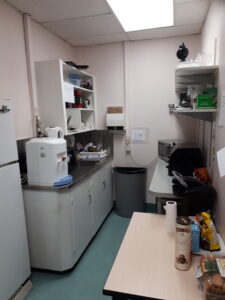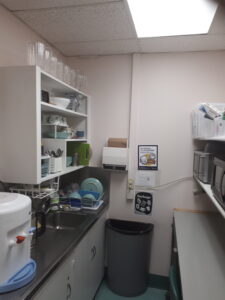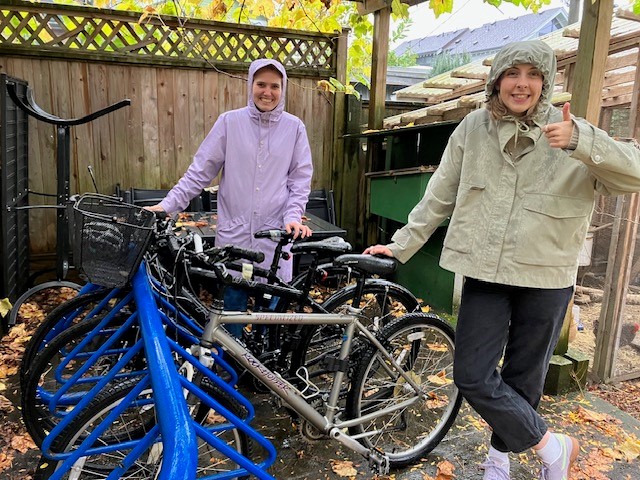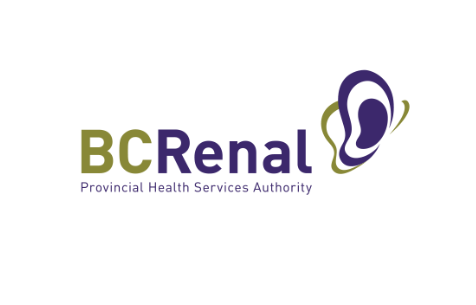Every year the Energy and Environmental Sustainability (EES) team collaborate with PHSA’s Healthy Promotion Initiative Fund (HPIF) team to support Green+Leader projects in energy and environmental sustainability. Over the years, about 210 participants have benefitted from this grant initiative. In 2022, HPIF’s sustainability grant stream distributed a total of approximately $10,000 to support ten projects, highlighted in the Green+Leaders annual report.
Staff at BC Children’s and Women’s cultivate the joy of healthy, fresh food at work
Staff members of the Complex Chronic Diseases Program at BC Children’s and Women’s Hospital and Health Centre in Vancouver established a new “green kitchen” to promote their own health and wellness at work. This project was a collaborative effort by a team of seven staff members, led by Occupational Therapist and Green+Leader Jennifer Mauritz and Registered Dietician Anita Wetzer. Throughout the process, the team leads consulted with all 30 staff members and asked for their input with decision-making.
We knew funding was available and we asked the team if there was a project we wanted to put forward,” says Jennifer. “We all wished we had a better kitchen space for food preparation.”
The staff also wanted to create a space that fostered team building and socialization. So, Anita and Jennifer applied to the Health Promotions Initiatives Fund (HPIF), a funding program established to support the physical, emotional, spiritual and/or social health and wellness of Provincial Health Services Authority (PHSA) employees. Their project was approved for the sustainability stream of the funds sponsored by the EES team and the Green+Leaders program.
Their application requested funding to acquire serving and tableware, kitchen tools for food preparation (such as salad containers, cutting boards, and storage containers), and shelving to store the new items. Their application was successful, so the team was able to declutter the kitchen, install the shelving at the end of 2022, and bring the project to life.
The “Green Kitchen” project follows the success of the team’s previous project, the Wellness Space, which improved a shared space for staff meetings, team huddles, and project work. They added a fresh coat of paint, changed the lighting, and added furniture for resting. “It changed how we come together as a team and we have access to a space where we can rest so we can perform well at work,” says Jennifer.
Similarly, the updated kitchen space has changed the way staff approach coming to work. Many now bring non-prepared food from home and assemble salads for lunch. In an evaluation survey of the project, the comments were exceedingly positive. One staff member said, “I love the new green kitchen. It gives me a sense of calm. Everything I need is there. Everything is very accessible, clean and green.”
The green kitchen has also reduced kitchen waste and made recycling easier.
We generate less plastic waste now, as more team members bring fresh food from home and prepare it in the kitchen,” explains Jennifer. “We used to have more takeout containers and plastic cutlery. Our compost bin is in the freezer and people know that it’s there. We’ve also created signage with waste diversion instructions and put it up in the space.”


The kitchen before the upgrade. The kitchen after the upgrade.
“If there is space given to come together as a team, that space can shift the way we connect with each other over food and food preparation,” she says. As one team member noted in the project survey, having lunch with their colleagues is “uplifting.”
100% of surveyed team members agreed that the Green Kitchen has enhanced their sense of well-being at work, fulfilling Jennifer and Anita’s goal from the beginning. The project successes demonstrate “the power of community,” notes Jennifer. “If we have the power to make positive change, that’s how we can care about each other as a team.”








